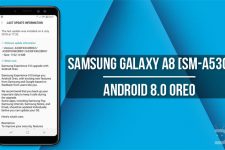![What's New In EMUI 8.0 Based On Android 8.0 Oreo For Honor V9 [DUK-AL20] - Download Firmware](https://www.droidviews.com/wp-content/uploads/2017/11/Honor-V9-oreo-emui-8.jpg)
Android 8.0 Oreo was released about two months ago and apart from Nexus and Pixel owners, and some Xperia owners, mostly everyone is still waiting for their Oreo updates. But if you’ve been in this Android update chain for long enough, two months does not really sound that long. But Google has given some hope by announcing that its major partners will be releasing Oreo updates by the end of the year. Sony, Nokia, and OnePlus have already started testing their Oreo builds and so has Samsung with its beta program. The second largest Android smartphone manufacturer, Huawei has too decided to jump in on the Oreo goodness via its sub-brand Honor. The company has rolled out Android 8.0 updates which features EMUI 8.0 on top to Honor V9 users in China.
EMUI 8.0?
Honor V9 is the Chinese variant of the internationally known Honor 8 Pro. The devices enrolled in Huawei’s beta program have received a beta version of Android Oreo-based EMUI 8.0. Wait a minute, EMUI 8.0? Yes, After EMUI 5.1 comes EMUI 8.0 because these folks skipped the math class in school. Lame jokes aside, Huawei probably skipped 6 and 7 so as to bring the EMUI version number on par with Android’s version number. One can see how that would ease some confusion among consumers.
Features
EMUI 8.0, since it is based on Android 8.0 and since the developers working for Huawei aren’t insane, has all of the usual Android 8.0 features you’d expect. Things like Picture-in-Picture, stricter background apps limitations, annoying notifications, notification channels, etc. Although notification channels are implemented in EMUI 8.0, its notification importance controls are actually not based on the AOSP version. These are a holdover from EMUI 5 instead and it’s a good thing. On Android Oreo, you actually lose notification importance controls for the apps that don’t target Android Oreo. That is fortunately not the case on EMUI 8.0.
Screen resolution
EMUI 8.0 does not feature a lot of changes on the surface compared to EMUI 5. But it does bring in a few new features that users have been asking for. For instance, EMUI 8.0 now manually lets you control the screen resolution of your device. This feature builds upon the Smart resolution feature from EMUI 5 which automatically switched resolution to save power.
Navigation bar
That is not the only feature to have been built upon though. EMUI 5 allowed users to add a new button to the right of the stock navigation buttons to pull down the notification shade. EMUI 8.0 lets you add another button which is a small arrow to the left of the navigation bar. Tapping on it hides the navigation bar until you swipe from the bottom to reveal it again. It may not be useful to everyone but there’s no denying that at times everyone does wish that the navigation bar would get out of the way for a moment.
There’s also the Navigation dock which when enabled places a moveable floating button on the screen. This button can replace all navigation bar functions like back, home, and Recents. EMUI 5 too has a similar feature called Floating dock. But the difference lies in the implementation. Floating dock simply revealed the three navigation buttons upon being tapped, and then you’d have to tap the button you actually wanted to tap. EMUI 8.0’s Navigation dock instead uses gestures – swipe up for home, swipe right for Recents, and touch to go back.
Other changes
First of all, a new update means that the Blueborne vulnerability has been fixed. Not so exciting but safety first. Moving onto the more exciting parts, EMUI 8.0 will bring Project Treble support to your device. Project Treble, if you haven’t heard, aims to make Android upgrades easier for the OEMs by separating the Android OS Framework from the vendor’s implementation.
But if that is not exciting, perhaps the fact that Substratum themes will work on EMUI 8.0 will be exciting. Thanks to the Overlay Manager Service (OMS) commits that Sony made to AOSP and then Google finally included in Android Oreo. Google’s own Pixel and Nexus devices have been enjoying Substratum theme support because of it. Sure EMUI has its own theme engine but it is no match for Substratum.
EMUI 8.0 also brings in Ambient Display and some camera app improvements.
Screenshots
Image Credit: OldDroid
![Install Android 8.0 Oreo Powered EMUI 8.0 Beta On Honor 8 Pro [Indian Variant]](https://www.droidviews.com/wp-content/uploads/2017/11/Honor_8_Pro_EMUI_8_Android_Oreo_2.jpg)
![Install Android 8.0 Oreo Powered EMUI 8.0 Beta On Honor 8 Pro [Indian Variant]](https://www.droidviews.com/wp-content/uploads/2017/11/Honor_8_Pro_EMUI_8_Android_Oreo_4.jpg)
![Install Android 8.0 Oreo Powered EMUI 8.0 Beta On Honor 8 Pro [Indian Variant]](https://www.droidviews.com/wp-content/uploads/2017/11/Honor_8_Pro_EMUI_8_Android_Oreo_5.jpg)
![Install Android 8.0 Oreo Powered EMUI 8.0 Beta On Honor 8 Pro [Indian Variant]](https://www.droidviews.com/wp-content/uploads/2017/11/Honor_8_Pro_EMUI_8_Android_Oreo_6.jpg)
![Install Android 8.0 Oreo Powered EMUI 8.0 Beta On Honor 8 Pro [Indian Variant]](https://www.droidviews.com/wp-content/uploads/2017/11/Honor_8_Pro_EMUI_8_Android_Oreo_9.jpg)
![What's New In EMUI 8.0 Based On Android 8.0 Oreo For Honor V9 [DUK-AL20] - Download Firmware](https://www.droidviews.com/wp-content/uploads/2017/11/Honor-8-Pro-Android-Oreo.jpg)



Join The Discussion: